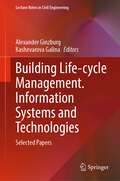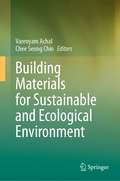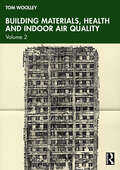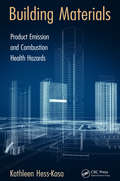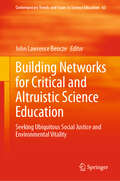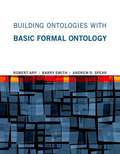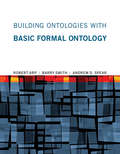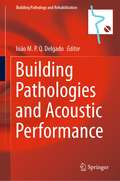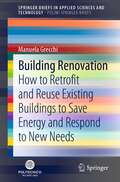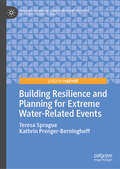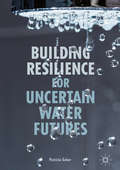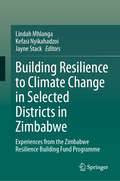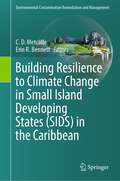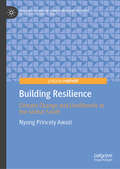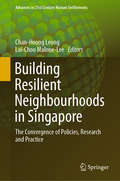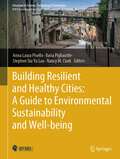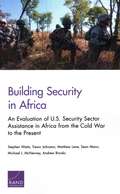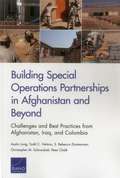- Table View
- List View
Building Life-cycle Management. Information Systems and Technologies: Selected Papers (Lecture Notes in Civil Engineering #231)
by Alexander Ginzburg Kashevarova GalinaThis book gathers the latest advances, innovations, and applications in the field of information systems and construction engineering, as presented by researchers and engineers at the International Scientific Conference Building Life-cycle Management. Information Systems and Technologies, held in Moscow, Russia on November 26, 2021. It covers highly diverse topics, including Information modeling technologies in building life-cycle management, Mathematical models and methods for building life-cycle management, Management of organizational processes in construction. The contributions, which were selected by means of a rigorous international peer-review process, highlight numerous exciting ideas that will spur novel research directions and foster multidisciplinary collaborations in the construction industry.
Building Marble Runs (Fun STEM Challenges)
by Marne VenturaWhat does it take to make a marble run? Gather some supplies and try it out for yourself! Discover tips and ideas on how to build the best marble run around!
Building Materials for Sustainable and Ecological Environment
by Varenyam Achal Chee Seong ChinThis book uses theories, hypotheses, policies, practical insights and case studies to introduce and elucidate green building materials for sustainable construction. Cement is the most widely used building material in construction; however, it is not sustainable, being responsible for 7% of global carbon dioxide emissions and consuming huge quantities of energy. In order to limit the ecological damage, sustainable building materials are needed. Ecosystems are a source of important lessons and models for transitioning the built environment onto a sustainable path that opens options for sustainable building material in construction. The book provides a guide for readers seeking knowledge on sustainable building materials with the potential to lower environmental impact by reducing CO2 emission throughout the building’s lifecycle. The book is motivated by recent rapid advances in sustainable building materials production, including green building materials made of industrial by-products and recycled wastes, earth materials, plant-based materials, microbial-based materials or supplementary cementitious materials, to reduce the environmental impacts of traditional building materials. Discussing the development and applications of various sustainable building materials, including related case studies, and addressing the environmental issue with a holistic and systematic approach that creates an ecology of construction for sustainability in infrastructures, it offers promising solutions to achieve renewable and sustainable building materials for the future.
Building Materials, Health and Indoor Air Quality: Volume 2
by Tom WoolleyIn Building Materials, Health and Indoor Air Quality: Volume 2 Tom Woolley uses new research to continue to advocate for limiting the use of hazardous materials in construction and raise awareness of the links between pollutants found in building materials, poor indoor air quality and health problems. Chapters in this volume reinforce previous arguments and present new ones covering: Further evidence of the health impacts of hazardous emissions from materials Hazardous materials to be avoided and why Fire and smoke toxicity – the Lakanal House and Grenfell Tower legacy Sub-standard retrofits leading to damp and mould in previously sound houses A critical review of recent reports from UK Government and others on air quality and health problems including policy changes on flame retardants Growing evidence of cancer risks and the failure of cancer research organisations to address these issues A critical review of recent climate change and zero carbon policies and a discussion on whether extreme energy efficiency is a good thing This book asks some important and, for some, uncomfortable questions, but in doing so it brings to light important areas for research and provides much needed guidance for architects, engineers, construction professionals, students and researchers on hazardous materials and how to reduce their use and design and build healthier buildings for all occupants.
Building Materials: Product Emission and Combustion Health Hazards
by Kathleen Hess-KosaThe construction industry is bombarded with ever-changing building materials—components of which are more and more difficult, if not impossible, to identify. Building material emissions have been implicated as a major source of indoor air pollution, and toxic gases, often unidentified, are generated in building fires. Building Materials: Product Emission and Combustion Health Hazards undertakes the task of identifying building materials emission and combustion health hazards. This practical guide introduces the complex world of polymers commonly used in building materials along with plasticizers and additives that are not regulated by OSHA. It also explores the topic of building materials as they relate to function and their emissions/combustion products along with thermal decomposition and combustion products as they relate to fire first responders. Engaging environmental professionals, construction management firms, architects, first respondents, and students, this valuable reference delivers a comprehensive spectrum of knowledge needed to face the challenges of managing building materials in the twenty-first century. Awareness is the first line of defense!
Building Networks for Critical and Altruistic Science Education: Seeking Ubiquitous Social Justice and Environmental Vitality (Contemporary Trends and Issues in Science Education #63)
by John Lawrence BenczeThis edited volume provides theory-based accounts, often with practical examples, of how educators from various jurisdictions in elementary, secondary, and tertiary formal education contexts, as well as community-based situations, have helped students critically evaluate the relationships among science, technology (STEM), society, and the environment. The goal is to develop and implement personal and sociopolitical actions to address concerns. Collectively, the perspectives and examples in the chapters form an expanding Foucauldian dispositif countering hegemonic mechanisms that favor a few elites at the expense of the wellbeing of most other living and nonliving things. Many accounts draw on the STEPWISE project, illustrating how (a)biotic and symbolic actants have been progressively assembled to promote more critical and altruistic citizenship.
Building Ontologies with Basic Formal Ontology
by Robert Arp Barry Smith Andrew D. SpearIn the era of "big data," science is increasingly information driven, and the potential for computers to store, manage, and integrate massive amounts of data has given rise to such new disciplinary fields as biomedical informatics. Applied ontology offers a strategy for the organization of scientific information in computer-tractable form, drawing on concepts not only from computer and information science but also from linguistics, logic, and philosophy. This book provides an introduction to the field of applied ontology that is of particular relevance to biomedicine, covering theoretical components of ontologies, best practices for ontology design, and examples of biomedical ontologies in use.After defining an ontology as a representation of the types of entities in a given domain, the book distinguishes between different kinds of ontologies and taxonomies, and shows how applied ontology draws on more traditional ideas from metaphysics. It presents the core features of the Basic Formal Ontology (BFO), now used by over one hundred ontology projects around the world, and offers examples of domain ontologies that utilize BFO. The book also describes Web Ontology Language (OWL), a common framework for Semantic Web technologies. Throughout, the book provides concrete recommendations for the design and construction of domain ontologies.
Building Ontologies with Basic Formal Ontology (The\mit Press Ser.)
by Robert Arp Barry Smith Andrew D. SpearAn introduction to the field of applied ontology with examples derived particularly from biomedicine, covering theoretical components, design practices, and practical applications.In the era of “big data,” science is increasingly information driven, and the potential for computers to store, manage, and integrate massive amounts of data has given rise to such new disciplinary fields as biomedical informatics. Applied ontology offers a strategy for the organization of scientific information in computer-tractable form, drawing on concepts not only from computer and information science but also from linguistics, logic, and philosophy. This book provides an introduction to the field of applied ontology that is of particular relevance to biomedicine, covering theoretical components of ontologies, best practices for ontology design, and examples of biomedical ontologies in use.After defining an ontology as a representation of the types of entities in a given domain, the book distinguishes between different kinds of ontologies and taxonomies, and shows how applied ontology draws on more traditional ideas from metaphysics. It presents the core features of the Basic Formal Ontology (BFO), now used by over one hundred ontology projects around the world, and offers examples of domain ontologies that utilize BFO. The book also describes Web Ontology Language (OWL), a common framework for Semantic Web technologies. Throughout, the book provides concrete recommendations for the design and construction of domain ontologies.
Building Pathologies and Acoustic Performance (Building Pathology and Rehabilitation #18)
by João M. P. Q. DelgadoThis book presents recent research works related to salt attack and corrosion in concrete structures, durability and service life in concrete, non-destructive techniques applied to reinforced concrete structures and acoustic performance of buildings. It identifies anomalies that affect the acoustic performance and the concrete structures, namely anomalies associated to salt attack and corrosion that affects the durability and service life of the buildings, in order to be eliminated in future projects. Offering a systematic review of the current state of knowledge, the book serves as a valuable resource for scientists, students, practitioners, and lecturers in various scientific and engineering disciplines, including civil and materials engineering, as well as and other interested parties.
Building Physics: Heat, Ventilation, Moisture, Light, Sound, Fire, and Urban Microclimate (Springer Tracts in Civil Engineering)
by Sašo MedvedThe book presents the theoretical background of building physics, dealing with the evaluation of physical phenomena related to heat transfer and energy use in buildings, water and water vapour transfer in building structures, daylighting and electric lighting of buildings, sound transmission in building structures and protection against noise, the occurrence and spread of fires in buildings and the thermal response of cities. It contains numerical and computational evaluation methods, numerous computational case studies and examples of experimental analyses. The book demonstrates that the considered physical processes affect the quality of living and working comfort in indoor and outdoor environment.
Building Professionals Facing the Energy Efficiency Challenge
by Géraldine Molina Marjorie Musy Margot LefrancThe aim of this book is to deepen the knowledge of dynamic evolution of professional practices (recomposition of knowledge and know-how, inter-relations, strategic positioning) taking place at the time of the injunction to energy efficiency in the design field, construction and management of real estate. From their experience feedback, the challenge of this book is to question the logic of innovation, to enlighten the dynamic learning and renewal of professional skills.
Building Renovation: How to Retrofit and Reuse Existing Buildings to Save Energy and Respond to New Needs (SpringerBriefs in Applied Sciences and Technology)
by Manuela GrecchiThis book reviews the building renovation process by systematizing the phases of analysis and prior knowledge through a project that not only considers energy savings but also thoroughly examines complex issues, such as defining the correct new functions and answers to new needs. The urgency of climate change and the many problems associated with the excessive use of energy are forcing a reorganization of the renovation process with an interest in reusing existing buildings with a more sustainable approach. The adaptive transformation of old buildings has become a dominant theme in many urban renewal projects. It must necessarily include strategies for energy efficiency, reduced pollutant emissions, improved environmental performance, economic sustainability and cultural identity. The examples selected are intended to provide evidence of good practices in the review and transformation of old buildings.
Building Resilience and Planning for Extreme Water-Related Events (Palgrave Studies in Climate Resilient Societies)
by Teresa Sprague Kathrin Prenger-BerninghoffThis book discusses what it means for cities to work toward and achieve resilience in the face of climate change. The content takes an urban planning perspective with a water-related focus, exploring the continued global and local efforts in improving disaster risk management within the water sphere. Chapters examine four cities in the US and Germany - San Francisco, San Diego, Solingen and Wuppertal - as the core case studies of the discussion. The chapters for each case delve into the current status of the cities and issues resilience must overcome, and then explore solutions and key takeaways learned from the implementation of various resilience approaches. The book concludes with a summary of cross-cutting themes, best-practice examples and a reflection on the relevance of the approaches to cases in the wider developing world. This book engages both practitioners and scientific audiences alike, particularly those interested in issues addressed by the Sendai Framework for Disaster Risk Reduction 2015-2030, the 2030 Agenda for Sustainable Development, the recent Water Action Decade 2018-2028 and the Rockefeller Foundation’s 100 Resilient Cities.
Building Resilience for Uncertain Water Futures
by Patricia GoberThis book describes the existential threats facing the global water systems from population growth and economic development, unsustainable use, environmental change, and weak and fragmented governance. It argues that ‘business-as-usual’ water science and management cannot solve global water problems because today’s water systems are increasingly complex and face uncertain future conditions. Instead, a more holistic, strategic, agile and publically engaged process of water decision making is needed.Building Resilience for Uncertain Water Futures emphasises the importance of adaptation through a series of case studies of cities, regions, and communities that have experimented with anticipatory policy-making, scenario development, and public engagement. By shifting perspective from an emphasis on management to one of adaptation, the book emphasizes the capacity to manage uncertainties, the need for cross-sector coordination, and mechanisms for engaging stakeholder with differing goals and conflict resolution. This book will be a useful resource for students and academics seeking a better understanding of sustainable water use, water policy and water resources management.
Building Resilience to Climate Change in Selected Districts in Zimbabwe: Experiences from the Zimbabwe Resilience Building Fund Programme
by Lindah Mhlanga Kefasi Nyikahadzoi Jayne StackThe book is based on Zimbabwe Resilience Building Fund data from the Outcome Monitoring Surveys 1,2,3 (OMS123) which comprised of three rounds of panel data set with the same households being interviewed three consecutive times in 18 districts. The OMS1, OMS2 and OMS3 were undertaken in 2019, 2020 and 2021, respectively. The findings in this book demonstrate and provide a better understanding of what works and what does not work to strengthen communities’ resilience in Zimbabwe. The information contributed in each chapter will be useful to inform adaptive programming and design of future resilience interventions and policy, with a focus on Climate Resilient Development (CRD). The chapters also address the challenge of formulating concrete policy in an environment with severe data constraints.
Building Resilience to Climate Change in Small Island Developing States (Environmental Contamination Remediation and Management)
by C. D. Metcalfe Erin R. BennettThis book summarizes approaches that integrate the environmental, economic, and physical domains with the values, and needs of the population are necessary to develop sustainable strategies that will enhance the resilience of small islands, within the context of inter-island differences in geology, ecology, societal attitudes, governance, and human and economic resources. The impacts of coastal damage and flooding are predicted to worsen during this century due to rising sea levels and increases in the frequency and intensity of storms. The usual approach to coastal protection in Small Island Developing States (SIDS) in the Caribbean is to view both the hazards and the solutions from the “Ocean Side” perspective and to react with “hard” engineering solutions. These structural engineering approaches prevent damage and disruptions to services associated with predictable events but leave communities vulnerable to future events that do not follow historical trends. Furthermore, engineered structures do not adequately address the systemic nature of climate change nor account for compounding threats (e.g., coincidence of hurricane season and global pandemics). To move from this traditional strategy for managing risks from coastal hazards, we need to consider a portfolio of solutions that enhance island protection and community resilience. Nature-Based Solutions (NBS) are gaining attention as practical and cost-effective approaches for mitigating climate-based stressors. However, deployment of NBS strategies requires spatial coordination within the context of “ridge to reef” or integrated water resource management (IWRM) approaches that include the creation of conditions for social acceptance, equity, effective governance, and financial incentives.
Building Resilience: Climate Change and Livelihoods in the Global South (Palgrave Studies in Climate Resilient Societies)
by Nyong Princely AwaziThis book explores the intersection of climate resilience, livelihoods, and sustainability in various sectors – from forestry to fisheries and agriculture – within the global South. The author provides a comprehensive examination of how climate change impacts these communities, the adaptive strategies they employ, and the policy frameworks necessary for promoting resilience. Through a multidisciplinary approach that integrates ecological, economic, and social dimensions, this book is an essential resource for policymakers, researchers, and practitioners in fields relating to fishery, forestry and agriculture in the global South.
Building Resilient Neighbourhoods in Singapore: The Convergence of Policies, Research and Practice (Advances in 21st Century Human Settlements)
by Chan-Hoong Leong Lai-Choo Malone-LeeThis book examines how institutional and environmental features in neighbourhoods can contribute to social resilience, highlighting the related socio-demographic issues, as well as the infrastructure, planning, design and policies issues. It is divided into three themes – infrastructure, planning, and community. Infrastructure examines how physical features such as parks and street patterns influence neighborliness and resilience, while planning studies how urban design enhances social interactions. Lastly, community discusses policies that can forge social bonds, either through racial integration, grassroots activities, or social service. Overall, the book combines research and empirical work with scholarly models of resilience and governance philosophy, focusing on Singapore’s urban planning and social policies.
Building Resilient and Healthy Cities: A Guide to Environmental Sustainability and Well-being (Advances in Science, Technology & Innovation)
by Anna Laura Pisello Stephen Siu Yu Lau Ilaria Pigliautile Nancy M. ClarkThis book presents a number of research papers that discuss how green urbanism is connected to promoting healthier living conditions. This is to reduce the impact of environmental changes including climate change, depletion of the earth's resources, and the emergence of infectious diseases and pandemics on humans. Addressing these challenges, the book at hand offers strategies and solutions that enable designers to bring together knowledge about sustainable and comfortable urban built environments, with an emphasis on the correlation between architecture, engineering, and medical facets in regard to comfort and well-being. Thus, the book is of significant importance to architects interested in the science of the built environment, climate change, and human resilience. This book is a culmination of selected research papers from the first version of the international conference on "Health & Environmental Resilience and Livability in Cities (HERL) - The challenge of climate change" which was held online in 2022 in collaboration with the University of Perugia, Italy, and the fifth edition of the international conference on Green Urbanism (GU) which was held online in 2021 in collaboration with the University of Rome.
Building Scientific Apparatus
by John H. Moore Christopher C. Davis Michael A. Coplan Sandra C. GreerSubtitled A practical guide to design and construction, this useful manual treats mechanical design, glass, optics, electronics, and temperature measurement and control. Annotation copyrighted by Book News, Inc. , Portland, OR
Building Security in Africa: An Evaluation of U.S. Security Sector Assistance in Africa from the Cold War to the Present
by Stephen Watts; Trevor Johnston; Matthew Lane; Sean Mann; Michael J. McNerney; Andrew Brooks;A RAND Corporation study used statistical models to evaluate the impact that U.S.-provided SSA has had on political violence in Africa--in particular, the incidence of civil wars and insurgencies, terrorist attacks, and state repression.
Building Security in the Persian Gulf
by Robert E. HunterThe United States must determine how best to promote long-term security and stability in the Persian Gulf region while seeking to reduce the risks and costs imposed by its role as a permanent regional power. The author analyzes Iraq's future, the role of Iran, asymmetric threats, regional reassurance, regional tensions, and the roles of other external actors. He then sets out criteria and requirements for a new regional security structure.
Building Simple Traps (Fun STEM Challenges)
by Marne VenturaWhat does it take to make a simple trap? Gather some supplies and try it out for yourself! Discover tips and ideas on how to build the best trap around!
Building Special Operations Partnerships in Afghanistan and Beyond: Challenges and Best Practices from Afghanistan, Iraq, and Colombia
by Peter Chalk Austin Long Todd C. Helmus S. Rebecca Zimmerman Christopher M. SchnaubeltBuilding the capacity of Afghan special operations forces (SOF) is a key goal of the United States and its coalition partners. This report summarizes key partnering practices and presents findings from SOF partnership case studies in Afghanistan, Iraq, and Colombia. The goal is to identify best practices to benefit the development of Afghan SOF, as well as for special operations partnerships beyond Afghanistan.
Building Strong Bridges (Fun STEM Challenges)
by Marne VenturaWhat does it take to make a strong bridge? Gather some supplies and try it out for yourself! Discover tips and ideas on how to build the best bridge around!
